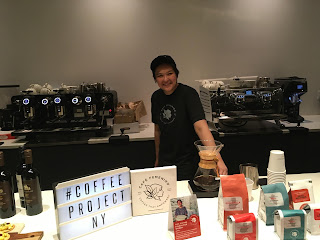 |
| Cooperatives like TUK in Rwanda offer farmers many benefits (Photo credit: Clay Enos and Sustainable Growers) |
In this blogpost we'll share the highlights, but we hope you'll consider hopping over to Roast's website to purchase the issue - either digital or hard-copy. $7 for the single issue or $35 for 1 year subscription.
Co-authors Ruth Ann Church and Dr. David L. Ortega review the growing interest in coffee produced by cooperatives, including two papers published in peer-reviewed journals by Michigan State University research teams. The first paper offers quantitative results on farmer productivity and household welfare from a study from Rwanda and the Feed the Future Africa Great Lakes Coffee support program. The second paper shares results from a coffee shop field experiment with consumers of pour-over coffee. It captures willingness-to-pay for coffee based on the organization of the producers, namely coffee that is labeled 'grown by farmers belonging to a cooperative'.
Insights from these quantitative studies bring credibility to qualitative work that has been popping up across the specialty coffee industry over the past year. The Specialty Coffee Association's Kim Elena Ionescu interviewed Merling Preza of PRODECOOP at Re:Co 2019 in Boston. The non-profit TWIN published a 2019 report on producer organizations that gleaned insights from 31 producer organizations in nine countries. The common theme is that the farmer cooperative can be a valuable node in coffee value chain, providing benefits to farmers that altruistic consumers, especially millennials, are expecting in their specialty food choices.
 |
| Cooperative members in Rwanda mitigate soil erosion for their coffee plot. |
 |
| Courtney Gates at Espresso Elevado in Plymouth, MI prepares a pour-over. (Photo credit: Teresa Pilarz) |
The article focusing on consumer willingness-to-pay (WTP) in Food Research International finds that when personality traits are used to segment consumers, a strong willingness-to-pay for coffee from farmers organized cooperatively can be identified. The results indicate:
- An
average WTP of an additional $1.31 per 12-ounce cup of pour-over
coffee, in a specialty coffee shop setting, when the cup descriptor is “coffee grown by farmers belonging
to a cooperative.”
- Consumers
with higher subjective knowledge (consumer’s self-evaluated knowledge of
coffee) had lower premiums for cooperative-grown coffee, suggesting that these
consumers may base their product valuation on sensory characteristics more than
descriptive information of production structure.
- The personality traits of “conscientiousness” and “extraversion” increase WTP and a higher level of the personality trait of “agency” or “outspokenness” decreases WTP (For more on the Big Six personality traits, see Bazzani, 2017, in Food Quality and Preference).
- Age was the only statistically significant sociodemographic determinant of WTP, with older consumers being willing to pay slightly more on average.
These results bring up complex topics long debated in the specialty coffee industry. For example, how do consumers value basic knowledge of the producer organization type (e.g. cooperative) vs. a voluntary sustainability standard such as Fairtrade? What role does the flavor and taste in the cup play in developing consumer WTP and repeat purchases? If a cup of coffee supplied by a farmer cooperative earns a premium over other coffee at a cafe, for example the $1.31 extra measured in the experiment, what portion of these funds makes it back to the coffee grower? These are all good questions which are recommended for further research.
 |
| Lee Harrison with Joe Coffee in New York City (Photo credit: Joe Coffee) |
What Should Roasters Do With the Info?
Would research that identifies willingness to pay based on personality traits be of interest at Joe Coffee? Harrison replies affirmatively. “Not just for sales and profitability here in New York, but for relationships at origin, too. If farmers had this information, they could better market themselves, and it would make our job of marketing their coffee more efficient,” he says.
 |
| Sunset at Kopakama cooperative near Lake Kivu, Rwanda |
 |
| Leaders of the Ejo Heza women's group appreciate one of the roaster customers, Victrola Coffee, who pays a premium. |
 |
| The Feed the Future Africa Great Lakes Coffee support program launched in August 2016 with a workshop in Kigali, Rwanda. (Photo credit: Michigan State University) |


























